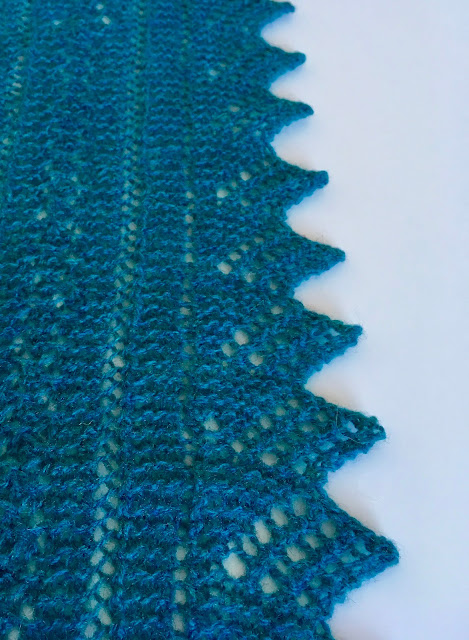While browsing publications for instructions on lace shawl knitting I came across The Magic of Shetland Lace by Elizabeth Lovick. The cover indicates the contents include stitches, techniques and projects for lighter than air shawls, just what I was looking for! However, it was the image on the front depicting light difused, delicate lace samples which inspired me to take a closer look inside.
The book has a stitch directory of essential Shetland lace knitting patterns. These are arranged into four categories: insertions, motifs, allover patterns and laces. I particularly like the samples in pastel colours which are photographed on a white background. The directory shows all the samples side by side so you can make comparisons. Each sample is referenced with the number of stitches and a row count. There are charts and written instructions for each design along with a larger image. There's also a "concentration level" guide, from 1 to 3 for each pattern (3 requiring the most concentration).
If you can knit and purl, do yarn overs and knit two togethers, this book claims to show you that Shetland lace knitting is with in your reach.
A very detailed chapter on how to put together a shawl design with helpful guidelines and practical examples gave me the confidence to try this myself.
The yarn I chose was, Jamieson's of Shetland Ultra, (x5, 25g balls shade Waterlily #690) knitted with Knit Pro Symfonie Rose Cubics size 4mm needles. The needles have a square cross section and are supposed to be ergonomically designed for a comfortable grip and produce more even stitches. They were easy to use except the dark rose wood colour, which combined with the dark shade of yarn I had chosen made seeing the stitches clearly more difficult. Once started I persevered, suspecting a change of needles part way through may have altered my knitting tension. Something I need to to bear in mind for the future.
The following is a description of the shawl I knitted along with the selection of stitches I used from the book. There's no coincidence that they all require the lowest level 1 category of concentration. That said, it was a project I needed to give my whole attention without distractions.
The following is a description of the shawl I knitted along with the selection of stitches I used from the book. There's no coincidence that they all require the lowest level 1 category of concentration. That said, it was a project I needed to give my whole attention without distractions.
There are 20 edging patterns. Attracted by the word "easiest", I chose Brand Iron Lace for the edging. Described as, "a common, old lace pattern... which works well in any yarn". It's worked over 12 stitches and includes, yarn overs, knit two togethers, cast off stitches. It's not difficult, the crucial thing is to keep count of the rows to maintain the pattern, the effect is quite striking and just as effective as some of the more complex edges requiring more concentration.
Two types of insertion were used, "Ladder" and "Bead" from the total of 13 described.
Next, the central panel uses an allover pattern called, "Fir Cone". This is worked over 10 stitches and 20 rows. It includes the instruction, knit three through the back loop, (k3tbl) and is much easier than it sounds.
Then, the previously mentioned insertions and edging are repeated on the other side.
While I chose the easiest patterns I liked from the book, the actual knitting required considerable concentration. Several errors remain, unfortunately, uncorrected after being discovered well after the event.
I'd certainly like to have a go at some of the more challenging stitch patterns but perhaps next time reduce the number of different elements which might help reduce the number of mistakes (and the length of time to complete it).







